1970 Triumph Trident T150
1970 TRIUMPH TRIDENT – A NEW LOOK
After the horrible styling experiment of the 1969 Triumph Trident in it’s introductory year, Triumph wisely decided to bring its big 750 Triple in line with the look people had come to expect from a Triumph, as typified by the Bonneville. Gone were the “Shoebox” gas tank, boxy side covers, and those gawd-awful “Ray Gun” mufflers. In were Bonneville-style teardrop tank, graceful sidecovers, and handsome exhaust megaphones. Finally, the might Trident was starting to look like something.
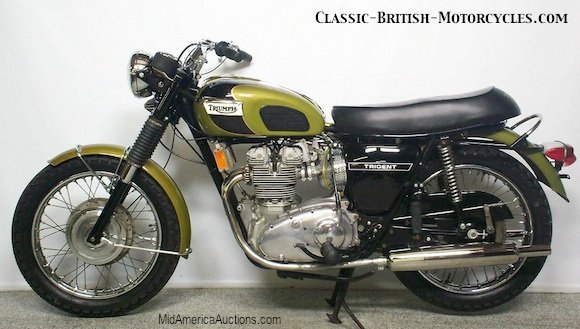
1970 TRIUMPH TRIDENT – THE LOOKS DIDN’T SLOW IT DOWN ANY
Despite the dorky looks, even the ’69 Trident went like the dickens. In other words, it was fast. Real fast! In fact, for a brief time, the Triumph Trident was renowned as the World’s Fastest Streetbike. That dubious honor was quickly taken back by the Norton Commando, only to be taken away from Norton by the game-changing Honda 750. Nonetheless, the 1970 Triumph Trident, and all Tridents and BSA Rocket 3s were fast, powerful, solid-handling machines, at a time when Japanese motorcycles were known for their “sketchy” handling.
<,br>
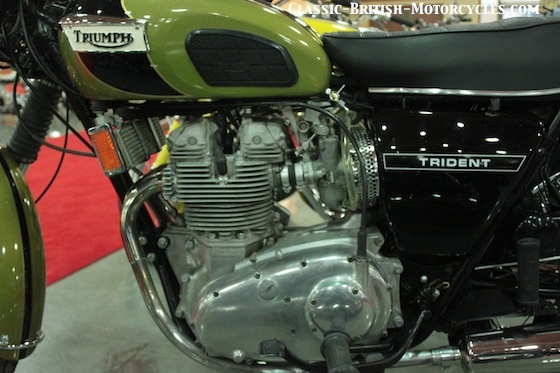
SLOW EVOLUTION FOR THE 1970 TRIUMPH TRIDENT
As was always the practice at Triumph, the Trident was developed over a slow evolutionary process, a little at a time over its entire lifespan. They never had the money to really go all-out the way the Japanese could. This is why it took the Brits so long to adopt 5-speed transmissions, disk brakes and electric starters, even on their biggest bikes, things that Honda, Kawasaki, Suzuki and Yamaha routinely put on not just their big bikes, but many of their midsize machines as well. Despite their noblest efforts with novel products like the Triumph Trident, the Brits were hopelessly outclassed, outgunned, out-engineered and out-spent by the Japanese Big-4.
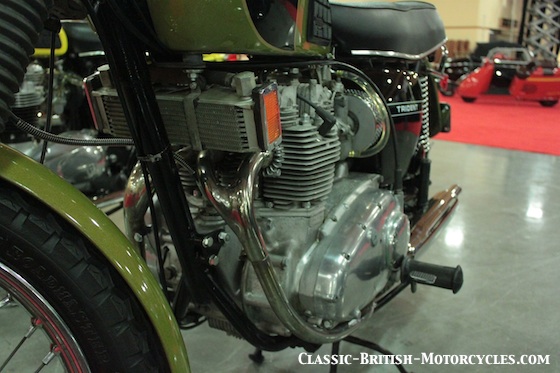
OILING IMPROVEMENTS MADE ON THE 1970 TRIUMPH TRIDENT
A myriad of detail improvements were made throughout the entire 1970 Triumph Trident. Of course, as already mentioned, all the bodywork was changed, completely changing the look of the bike. Great effort was made to try to improve upon the rather poor oil tightness of the engine. Assembled from 4 major cast sections, joined with complex vertically-split surfaces, the crankcases of the Trident and BSA Rocket 3 were notorious for leaving a puddle of oil wherever they went. Gasket mating surfaces were widened and gaskets were fitted where none had been before. But while the ground may have gotten too much oil, the 2 center crankshaft main bearings weren’t getting enough. The fix was to block off the oil passages leading from the center main bearing caps to the cams and tappets, which were found to get plenty of oil via the splash method. Modifications were made to the oil pump and its drive gear. This and a larger diameter top end oil tube kept the entire engine well lubricated.
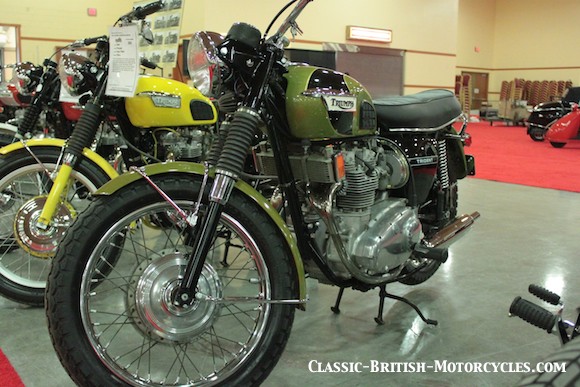
OTHER CHANGES TO THE 1970 TRIUMPH TRIDENT
Other changes and/or improvements to the 1970 Triumph Trident included a new head gasket, a seal installed behind the gearbox sprocket, revised rubber shock absorbers inside the clutch, ventilating the clutch cover to improve cooling in an attempt to alleviate clutch slippage, and the kickstart gearing was raised, using Triumph Bonneville components to make it easier to kick start. The internal gearbox ratios were reshuffled, and the final gearing was made lower (numerically higher) by changing the rear sprocket from 52 teeth to 53. While improving acceleration, it degraded fuel economy, which was already pretty deplorable.
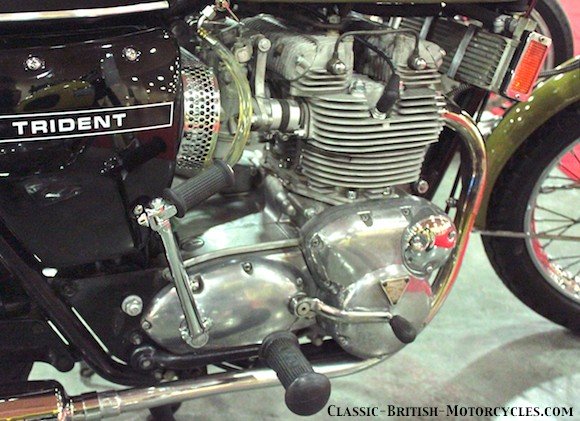
1970 TRIUMPH TRIDENT – A FAVORITE AMONG COLLECTORS
The Triumph Trident is a bike with presence, and a unique look and sound. There’s nothing like the wail of a Triumph triple in full throttle. And all this charm has not been lost on classic motorcycle enthusiasts, collectors, restorers and clubs. With only about 27,000 Tridents built over its entire 8-year lifespan, the demand for these awesome bikes remains high. Auction prices have slowly been rising, but there are still bargains out there. But get a good one. Don’t try to save money by buying a fixer-upper, then fixing it up yourself. That never works. You always end up spending more than it would have cost to just buy a nice example to start with. And a lot less time and hassle. But of course, if you love Triumph Tridents, then you won’t consider that a hassle.
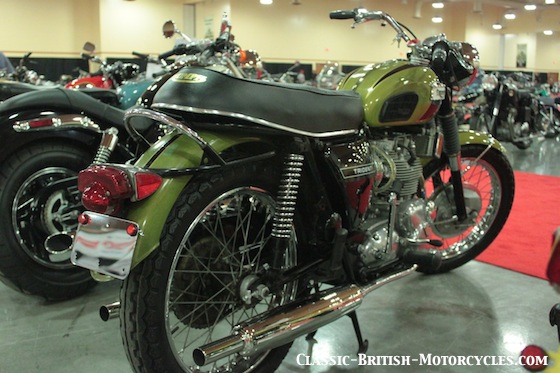
1970 Triumph Trident SPECIFICATIONS
|
Model Designations Engine type Engine configuration Engine Displacement Bore & Stroke Compression Ratio Horsepower Ignition type Electrical System Contact Breaker Gap Setting Advance Range Fully Advanced at Carburation Amal type Main Jet size Needle Jet size Needle type Needle position Primary Drive Clutch Gearbox Shifting Shift Pattern Gearbox Internal Ratios: 4th 3rd 2nd 1st Overall Ratios: 4th 3rd 2nd 1st Final Drive: Gearbox Sprocket Wheelbase Overall Length Overall Width Overall Height Ground Clearance Seat Height Unladen Weight Engine Weight Engine Lubrication Front Suspension Rear Suspension Front Brake Rear Brake Front Tire size Front Tire type Rear Tire size Rear Tire type |
T150 4-stroke, air-cooled traverse inline 3-cylinder 741cc / 45ci 67mm X 70mm 9.0:1 58hp @ 7,250rpm Points & Coils 12 volts DC .014-.016″ / .35-.40mm 12 degrees / 24 degrees (crank) 2,200rpm 3-Amal 26mm Concentrics Mk I 150 106 STD 2 triple-row chain single-plate, dry, diaphram 4-speed constant mesh right foot 1-down, 3-up 1.00:1 1.26:1 1.71:1 2.47:1 5.26:1 6.64:1 9.00:1 13.00:1 18 teeth 56.25″ / 142.875cm 86″ / 218.44cm 33″ / 84cm 43.5″ / 100.49cm 6.5″ / 16.51cm 32″ / 81.28cm 460 lbs / 208.8kg 180 lbs / 81.72kg dry sump telescopic, hydraulic swing arm, 2 shocks 8-inch TLS drum 7-inch SLS drum 3.35 X 19″ Dunlop TT100 4.10 X 19″ Dunlop TT100 |


